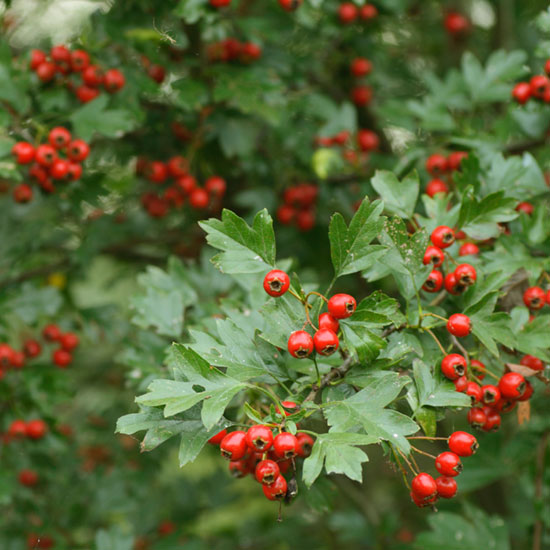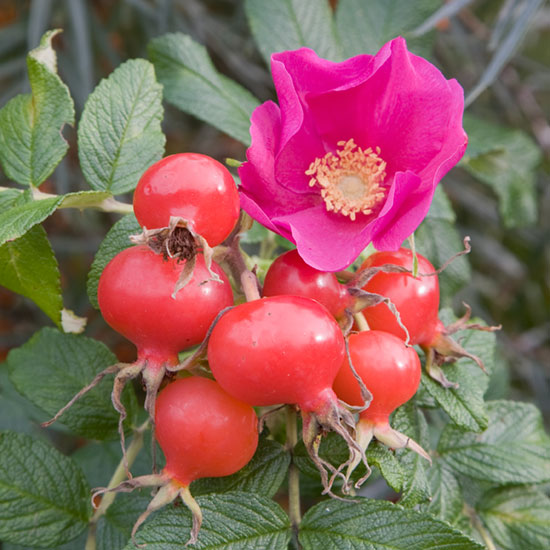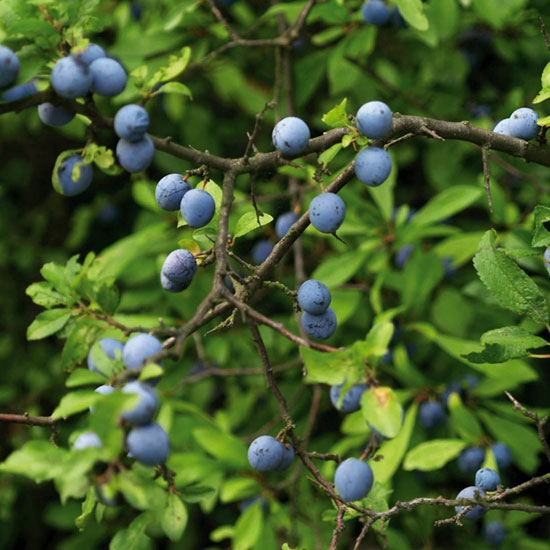Yes I really mean an edible hedge! It’s certainly a much cheaper and more attractive way of creating a boundary than erecting a fence or building a wall and if you don’t have space for a boundary hedge or have an existing hedge which you can’t convert, how about screening a compost bin, shed or vegetable plot? Perhaps the best thing is to consider an edible hedge as an extension to your existing fruit plot thereby extending your range of fruit cultivation to the very limits of your garden. If planted properly bare-root plants should fill out happily in just a couple of years, and may start fruiting the year after planting. Any produce not eaten by you will be happily devoured by the wildlife and birds in particular – who will also enjoy nesting and roosting in the tightly knit heart of an established hedge – so everyone’s a winner!

Hawthorn – A fast growing hedge producing masses of scented white flowers in the late spring followed by small bright red berries (haws) in the autumn. The fruits are edible and can be made into jellies, jams and syrups.
Hedges are a natural part of most landscapes, especially in urban and suburban areas and so why not use them for your benefit? Homeowners often grow hedges to define their property boundaries, block an unsightly view, or keep animals and people from wandering into their gardens. Hedges are much friendlier than fences and walls and offer anyone interested in fruit growing an additional opportunity to grow some fruit and yet have a living boundary; growing an edible hedge is a good way to soften the blow of your property’s limits. The edible side of the hedge is one bonus but spring time will also bring rewards when everything is in flower. The sight – and smell – of densely planted edible hedging is just magnificent!
Of course there are certain things to consider when growing an edible hedge. What will be the function of the hedge – for example if it is a property boundary and you wish to keep people and animals out you may wish to either plant quite densely (so as to form an impenetrable barrier) or incorporate some particularly prickly plants such as blackberry, gooseberry, dog rose, hawthorn, sloe or rugosa rose. You will need to consider the ultimate height of the hedge – if you’re growing it to either block a view or use it as a less impenetrable boundary you probably want it to be manageable which generally means an ultimate height of 1.2-1.5m (4-5ft) and ideal plants are the dog rose, cherry plum, cornelian cherry, hawthorn, rugosa rose or sloe. Remember that these hedges will be deciduous which means that they will lose their leaves in winter. Dense planting – which is quite natural for hedging – will ensure a minimum of transparency!

Rugosa Rose – A fast growing, prickly hedge bearing large fragrant magenta flowers in the summer and huge orange-red rose hips in the autumn. The hips can be used to make syrup, wine or jelly.
Unless you particularly want a hedge of one plant type always go for a mixed edible hedge as this provides diversity of plants for wildlife and an interesting mix of foliage, flowers, and berry colours and textures. While the plants don’t all have to be the exact same size in the hedge, it’s good to select ones that are similar in growth habits so that no one plant dominates the hedge. Also, consider the growth habit of the hedge – blackberries and roses are some of the plants that will spread by underground roots. This could be a benefit if you want your hedge to fill in quickly, but also can get out of control when suckers show up in flower beds and other unwanted areas.
If you so wish you can also train the more traditional fruit trees into fences and hedges that make for a good barrier. Espalier apples and pears along with fan trained cherries, plums, peaches and nectarines can be used as an edible hedge but by their very nature will not be so dense as the woodland type plant and will be considerably more expensive to plant. This type of barrier is, perhaps, best used for a more ornamental use closer to habitation. The same applies to stepover apple and pear trees – which, in effect, are single tier espalier trees. These can form low, ornamental barriers which can be used, for example, at the edges of vegetable plots or even garden borders. Usually these trees will be trained to be no higher than 45-60cm (18in-2ft) high.
You can buy hedging plants that will come bare rooted and usually in small bundles. I suggest that you carefully look through the Pomona Fruits catalogue as it is one of the best around. If you buy from Pomona Fruits you will be supplied with bushy two year old plants and if you look after them well they will very quickly get away and grow strongly. Incidentally as soon as your plants arrive you should look to plant them but if you are unable to do this ‘heel’ them into the ground until you are able to do so.
As these hedging plants will be planted quite closely and need a good start to get them going it is best to follow a set of simple rules:
Several weeks before planting, clear the area of pervasive weeds and dig over the soil removing any large roots or stones and incorporate some well-rotted compost or manure if you possibly can. On the day of planting, place the bundles of bare-root plants into a bucket of water a couple of hours before planting. Plant out at a distance of approximately 60cm (2ft) apart unless the instructions received with your plants recommend otherwise. Ideally to achieve maximum thickness of hedging you should plant two staggered rows approximately 60cm (2ft) apart. To ensure good, strong root growth incorporate Rootgrow mycorrhizal fungi directly onto the roots of the plants before planting. To encourage dense, bushy hedging you should cut all stems back to approximately 30cm (1ft) above ground level as soon as you have planted them.
Although not critical you will find that if your budget allows it will be of great value if you use polypropylene ground cover such as Permealay along the line of the hedge as this will not only prevent weeds growing but will also help retain moisture. You can cover this with bark or soil later if you want it to ‘disappear’. Cut slits in the material where the plants are to go and then plant through them.
Good watering in the first year is absolutely vital if your hedging is to establish itself well. Keep the ground around the plants moist during the whole growing season particularly in times of little or no rain. In future years you will only need to water well in times of prolonged drought. If you are not using polypropylene ground cover ensure that you keep the whole area of the hedging free of weeds in the first year – a mulching of well-rotted compost will help here.
As your hedge starts to establish you will need to keep the hedge trimmed unless you decide to go for a ‘wild’ hedge i.e. one that lets all the plants grow to their natural height. If you are trimming do so in mid-summer and late winter to create a fairly neat hedge line and appearance. In the early years of the hedge cut back all growth by about a half to encourage good bushy growth.
So what plants to choose for your hedge and what can the fruits be used for? The following gives a few examples:
a) For fresh or cooked fruit – cherry plum, hazel and wild cherry
b) For jellies and jams – cornelian cherry, dog rose, hawthorn and rugosa rose
c) For drinks – elder, golden elder and sloe
Hopefully I have whetted your appetite in more than one way so why not have a go at planting an edible hedge this winter?
Gerry Edwards
19th February 2014
Gerry is an experienced amateur fruit grower who is Chairman of the RHS Fruit Group, a member of the Royal Horticultural Society’s Fruit, Vegetable and Herb Committee and also their Fruit Trials Panel. Gerry judges fruit nationally for the Royal Horticultural Society and is also a qualified National Vegetable Society judge.


would you stock any hedging that’s good for birdlife and green all year and grows at least 8ft thank you
Hi Michael
Pyracantha is evergreen and produces lovely red, orange or yellow berries enjoyed by the birds. It will also reach 8-10ft in height. We do not stock it, but should be able to get hold of it. If this is of interest please contact us via our website with your details and we will get back to you with a quotation.
thank you for your reply it is 8 metres of hedging I require could I have quote thank you
Hi Michael
If you can email us with your full address details at [email protected], we will provide you with a quotation.